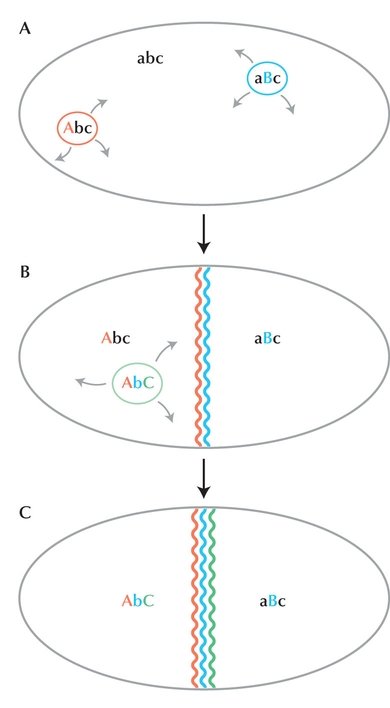

Figure WN22.10. Dobzhansky–Muller divergence within a population spread over a broad area (i.e., in parapatry). (A) Initially, the population carries alleles a, b, c, ... . A favorable allele A rises in one place and begins to increase at the expense of a; meanwhile, an allele B at another locus starts to spread somewhere else. (B) If A and B are incompatible, as in the Dobzhansky–Muller model (Fig. 22.24), two stable clines will form where the alleles meet each other. (C ) If an allele C is favorable when combined with Ab but is incompatible with aB, then it will strengthen divergence by forming a third stable cline. We have shown only alleles that contribute to incompatibility: Most favorable alleles are likely to spread through the whole population and so will not contribute to divergence. If there is a barrier to gene flow across the species’ range, it will slow the spread of favorable alleles, making it more likely that they will meet an incompatibility before fixing throughout the range.
| © 2007-2010 by Cold Spring Harbor Laboratory Press. All rights reserved. |
| The reproduction, modification, storage in a retrieval system, or retransmission, in any form or by any means, electronic, mechanical, or otherwise, for reasons other than personal, noncommercial use is strictly prohibited without prior written permission. You are authorized to download one copy of the material on this Web site for personal, noncommercial use only. The material made available on this Web site is protected by United States copyright laws and is provided solely for the use of instructors in teaching their courses and assessing student learning. Dissemination or sale of any of this material, as a whole or in parts (including on the World Wide Web), is not permitted. All users of these materials and visitors to this Web site are expected to abide by these restrictions. Requests for permission for other uses of this material should be directed to Cold Spring Harbor Laboratory Press, 1 Bungtown Road, Cold Spring Harbor, NY 11724 or submitted via our World Wide Web Site at http://www.cshlpress.com/. |